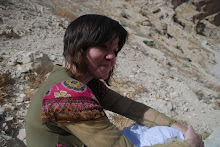Here is an image of him taken just over a year ago on the 11th April 2008 marching with the rest of the men of Bilin to hold the weekly non violent protest against the illegal wall built on their village lands.

Just before the start of the demonstration he showed me barrels of used CS gas cartridges and remnants of sound bombs that the Israelis had fired during the protests.


Remnants of sound bombs.

All collected by the villagers from the lands around Bilin following the protests.

Palestinian killed in Bilin protest
Local demonstrator seriously injured by tear gas canister hit to his chest during anti-fence rally, dies of wounds shortly after reaching hospital. IDF says protest was violent. Demonstrators: We're like sitting ducks; soldiers fire at anything that moves; army, PA investigating Ali Waked and Anat Shalev
| Palestinian sources reported Friday that a local demonstrator was killed after being hit in the chest by a tear gas canister during a protest against the separation fence in the West Bank village of Bilin.
The man, 30-year-old Bassem Ibrahim Abu-Rahma from Bilin, was evacuated to a Ramallah hospital in serious condition, where he then died of his wounds. The army confirmed the report of Abu-Rahma's death.
Representatives of the IDF and the Coordination and Liaison Authority met with Palestinian officials later in the day as part of the joint investigation into the incident. |
Follow the link to see video:
http://www.ynet.co.il/english/articles/0,7340,L-3702569,00.html
http://imemc.org/article/60009
http://www.maannews.net/en/index.php?opr=ShowDetails&ID=37179
















